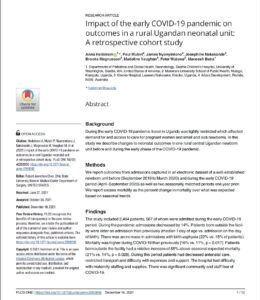
Background
During the early COVID-19 pandemic travel in Uganda was tightly restricted which affected demand for and access to care for pregnant women and small and sick newborns. In this study we describe changes to neonatal outcomes in one rural central Ugandan newborn unit before and during the early phase of the COVID-19 pandemic.
Methods
We report outcomes from admissions captured in an electronic dataset of a well-established newborn unit before (September 2019 to March 2020) and during the early COVID-19 period (April–September 2020) as well as two seasonally matched periods one year prior. We report excess mortality as the percent change in mortality over what was expected based on seasonal trends.
Findings
The study included 2,494 patients, 567 of whom were admitted during the early COVID-19 period. During the pandemic admissions decreased by 14%. Patients born outside the facility were older on admission than previously (median 1 day of age vs. admission on the day of birth). There was an increase in admissions with birth asphyxia (22% vs. 15% of patients). Mortality was higher during COVID-19 than previously [16% vs. 11%, p = 0.017]. Patients born outside the facility had a relative increase of 55% above seasonal expected mortality (21% vs. 14%, p = 0.028). During this period patients had decreased antenatal care, restricted transport and difficulty with expenses and support. The hospital had difficulty with maternity staffing and supplies. There was significant community and staff fear of COVID-19.
Interpretation
Increased newborn mortality during the early COVID-19 pandemic at this facility was likely attributed to disruptions affecting maternal and newborn demand for, access to and quality of perinatal healthcare. Lockdown conditions and restrictions to public transit were significant barriers to maternal and newborn wellbeing, and require further focus by national and regional health officials.